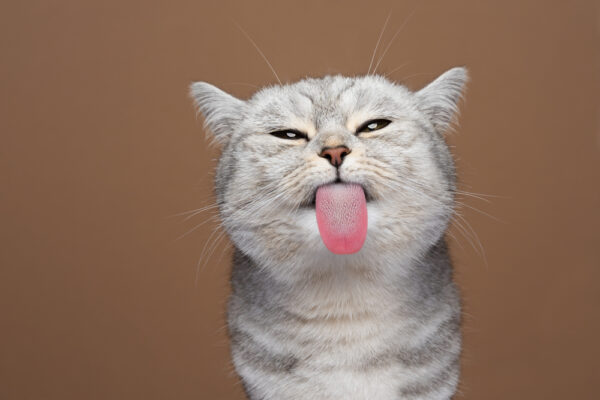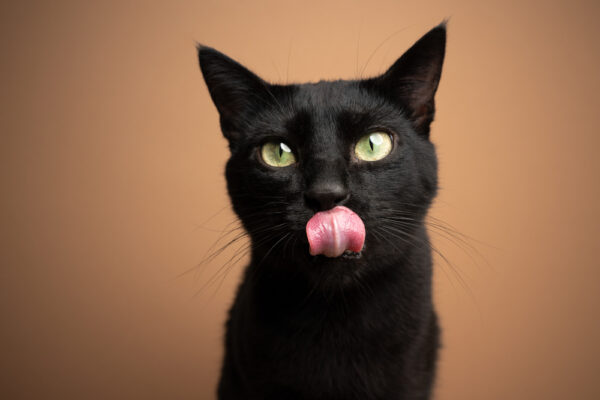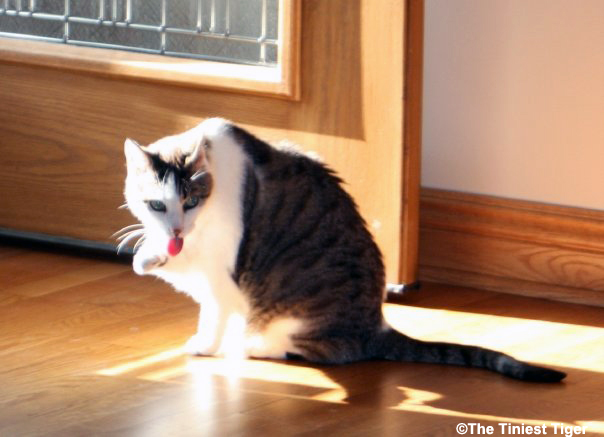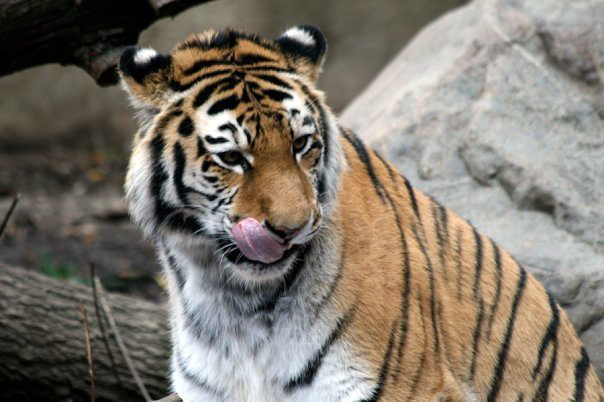
Cat Tongue
The cat tongue is a fascinating and unique part of feline anatomy that serves a variety of important functions. Its rough texture and specialized design help cats with grooming, eating, and even regulating body temperature. In addition to its functional capabilities, a cat’s tongue can also be a window into its health and behavior.
Anatomy-wise, a cat’s tongue is covered in small, hook-like structures called papillae, which allow it to effectively groom its fur, removing dirt and debris while spreading natural oils – this is crucial for maintaining skin health and keeping the coat clean and tangle-free. Moreover, the presence of these papillae enhances a cat’s sense of taste and plays a vital role in capturing food. Much like other aspects of a cat’s anatomy, the tongue is impressive in its design and how it works alongside other features to create a highly adaptive and efficient creature.
Key Takeaways
- A cat’s tongue is equipped with specialized structures called papillae, helping with grooming, eating, and maintaining body temperature
- Studying the cat tongue can reveal insights into feline health and behavior
- Specific cat breeds may exhibit variations in tongue morphology and color, impacting their various lifestyle and grooming needs
Anatomy of a Cat’s Tongue
Papillae and Spines
A cat’s tongue is composed of various types of papillae, which are small, protruding structures that give the tongue its rough texture. One of the most notable types of papillae on a cat’s tongue are the filiform papillae. These filiform papillae are covered in keratin, making them rigid and spiny. This study shows that they are found in different regions of the cat’s tongue and have varying shapes and sizes depending on their location. The spines on the filiform papillae help the cat in grooming and removing loose hair from its coat.
The other types of papillae on a cat’s tongue include fungiform, foliate, and vallate papillae. Fungiform papillae are mushroom-shaped structures while foliate papillae appear as a series of grooves in the back of the tongue. Vallate papillae are large circular structures surrounded by a groove, and are found near the base of the tongue.
Taste Buds
Taste buds allow cats to perceive various flavors and are found within the papillae, specifically the fungiform, foliate, and vallate papillae. Cats have fewer taste buds than humans, with approximately 400 to 500 taste buds, whereas humans have around 9,000. This difference in taste bud count is one of the reasons cats have a more limited sense of taste compared to humans.
Cats are known to be obligate carnivores, meaning their diet consists almost entirely of animal-based protein. Therefore, their taste buds have evolved to fit their dietary needs. For example, cats lack the ability to taste sweetness, as their taste buds do not have the receptors needed to detect sugar. This adaptation can be linked to their natural preference for a meat-based diet. In contrast, cats are highly sensitive to the taste of bitter and sour substances, which is likely a protective mechanism to avoid potentially toxic and spoiled foods.
In summary, the anatomy of a cat’s tongue is specialized to meet their specific grooming and dietary needs. The unique structure of their tongue supports their feeding habits as obligate carnivores and grooming abilities, while their taste buds are adapted for a more limited range of flavors.

Functions of a Cat’s Tongue
Grooming
A cat’s tongue plays a crucial role in grooming. The tongue is covered with tiny, backward-facing barbs called papillae, which help to remove loose hairs, dirt, and debris from the fur. When grooming, a cat licks its fur, and the papillae act like a comb, untangling and cleaning the hairs. Grooming also helps to distribute natural oils from the skin throughout the fur, keeping it shiny and healthy.
Some of the hairs that are caught by the tongue during grooming may be swallowed which can lead to the formation of hairballs. Cats have a strong gag reflex that usually helps them to cough up these hairballs, but occasionally they may require intervention from a veterinarian.
Eating and Drinking
Cats have evolved as carnivorous animals, and their tongue is adapted for capturing and consuming prey. The sharp, hook-like papillae on the tongue assist in gripping and holding onto meat, as well as tearing it into smaller pieces. When eating, a cat uses its tongue to lap up small pieces of food which are then drawn back into the mouth for chewing and swallowing.
Drinking water is also facilitated by the unique structure of the cat’s tongue. When a cat drinks, it curls its tongue backwards, forming a spoon-like shape. This allows it to quickly lap up water and draw it into the mouth using a combination of gravity and surface tension. Cats drink in this manner to minimize the contact between their mouth and the water, reducing the risk of ingesting potentially harmful substances.

Health Indicator
A healthy cat will have a clean and moist tongue, indicating that it is producing adequate amounts of saliva. Saliva serves several purposes, including assisting in digestion and maintaining oral hygiene by washing away food particles and bacteria. In addition, cats use their tongues to help regulate body temperature through panting, as the saliva evaporates, it cools down the blood vessels present in the tongue.
Changes in a cat’s tongue, such as dryness, discoloration, or unusual coating, can be a sign of an underlying health issue. If you notice any of these symptoms in your cat, it is important to consult a veterinarian for a proper evaluation and treatment plan.
Cat Tongue Health Issues
Drooling
In some cases, excessive drooling can indicate a health issue with a cat’s tongue. Drooling may be a sign of oral pain or discomfort due to dental issues, gum inflammation, or even foreign objects stuck in the mouth. If drooling is accompanied by other symptoms such as loss of appetite or bad breath, it is advisable to consult a veterinarian for proper diagnosis and treatment.
Inflammation
Inflammation of the tongue, also known as glossitis, can cause a cat to experience oral discomfort. This condition may result from various factors such as allergies, infection, or injury. Signs of an inflamed tongue include redness, swelling, and difficulty eating or grooming. A veterinarian should be consulted to determine the underlying cause of the inflammation and prescribe appropriate treatment to alleviate the cat’s discomfort.
Ulcers
Ulcers can form on a cat’s tongue due to various reasons, including viral infections, immune-mediated disorders, or exposure to irritants such as chemicals or foreign objects. These painful sores can interfere with the cat’s ability to eat and groom, and may lead to weight loss and a decline in overall health. When ulcers are present, a veterinarian should be consulted to diagnose the underlying cause and provide appropriate treatment options.
In conclusion, paying attention to the health of a cat’s tongue is crucial as it can be an indicator of underlying health issues. Routine veterinary checkups can help identify and address any tongue-related concerns, ensuring the overall well-being of the cat.
Unusual Cat Tongue Colors
Blue
A blue-colored tongue in your kitty can be a sign of oxygen deprivation or poor circulation. This may occur due to various medical conditions, such as heart disease, respiratory distress, or shock. If you notice that your cat’s tongue has turned blue or has a bluish tint, it is essential to consult a veterinarian immediately to assess the underlying cause and initiate appropriate treatment.
Pale
A pale tongue in cats may indicate anemia or a lack of red blood cells. Anemia can be caused by several factors including blood loss, poor nutrition, or underlying diseases such as kidney failure. If your cat’s tongue appears pale, it is important to schedule a visit to your veterinarian to identify the cause and begin treatment.
Yellow
A yellow-colored tongue in cats is usually associated with a condition called glossitis, which is inflammation of the tongue. Glossitis can be caused by various factors, including infections, chemical irritants, or underlying health issues like liver disease. The yellow coloration is often due to the accumulation of bilirubin, a waste product that is processed by the liver. If you observe a yellow tongue in your kitty, it is essential to seek veterinary care to diagnose and treat the underlying condition.
In conclusion, unusual cat tongue colors can indicate different health concerns, and it is crucial to monitor your cat’s tongue for any changes. If you notice your cat’s tongue exhibiting any of these colors – blue, pale, or yellow – make sure to consult a veterinarian for further evaluation and treatment.

Cat Tongue and Behavioral Insights
Licking Behavior
A cat’s tongue is a unique tool that serves various purposes, from grooming to consumption. It has tiny, backward-facing barbs called papillae, which aid in the cat’s grooming process by effectively combing through the fur and catching dead hair or debris. Cats are known to groom themselves regularly, and this behavior helps to keep them clean and reduce the risk of developing skin infections.
High-speed videos show that when a cat licks, they tend to move their tongue in a relatively wide range, often extending it past their chin. This wide motion assists in covering a larger area while grooming. Also, the cat’s tongue can reach and latch onto objects in the environment, such as toys or food, to manipulate them. Some research even shows that cat tongues can be used to access food or water from small capsules.
Lastly, it is essential to note that excessive licking can indicate stress or an underlying health issue. If you observe a sudden change in your cat’s licking behavior, it is vital to consult a veterinarian for a thorough examination and appropriate intervention.
Drinking Patterns
Cats, being desert-originated animals, have evolved to consume moisture from their prey. However, they still need water to stay properly hydrated, especially if they’re on a dry diet. Drinking patterns in felines are quite unique due to the way their tongue is structured.
Instead of scooping water into their mouths like dogs, cats use a delicate balance of gravity and inertia to drink. They curl their tongue backward, forming a spoon-like shape, to draw water upward into their mouths by quickly flicking their tongue. The high-speed videos reveal that the cat’s tongue barely touches the surface of the water, reducing the possibility of contaminants getting into their mouths.
To encourage cats to drink more water, consider using a shallow bowl, preferably larger in diameter. Wide, shallow bowls allow cats to drink without their whiskers touching the edges, which can be uncomfortable and discouraging for the cat. Additionally, placing multiple water bowls throughout the living space, or investing in a cat water fountain with a circulating system, can also aid in maintaining optimal hydration.
Cat Tongue Variances in Different Breeds
Persian Cats
One of the most distinct features of Persian cats is their long, luxurious fur. This specific breed has a unique tongue adapted for grooming purposes. Their papillae, the small, hook-like projections on the surface of their tongue, are designed to effectively detangle and clean their thick coat. However, this specialization may hinder their ability to perform other functions such as lapping water or capturing prey as efficiently as other breeds.

Wild Cats
In contrast to domesticated breeds such as Persian cats, wild species of felids like lions and tigers have evolved different tongue characteristics to suit their predatory lifestyles. Their papillae are more prominent and pointed, allowing them to better strip feathers, fur, and meat from their prey. This effective tool for consumption also aids in their ability to drink water more efficiently.
House cats, including both Persian cats and common domestic cats, exhibit a variety of tongue variances as well. These differences are primarily related to their diet and grooming behavior, with each cat adopting unique characteristics that best suit its needs.
Frequently Asked Questions
What makes a cat’s tongue rough?
A cat’s tongue is rough due to the presence of tiny, backward-facing barbs called papillae. These keratin-based structures cover the surface of the tongue, giving it a sandpaper-like texture. The papillae help in grooming and removing loose fur, as well as aiding in the consumption of food.
Are there any unique features of a cat’s tongue?
One unique feature of is its flexibility and mobility. Felines can manipulate their tongue in various ways to groom themselves efficiently. Additionally, cats have fewer taste buds than humans, making them less sensitive to certain flavors.
What causes a cat’s tongue to change color?
Changes in a cat’s tongue color can indicate health issues. For instance, paleness may result from anemia, while a yellow or brownish hue can signify liver problems. Other factors, such as dehydration and oral infections, may also cause color changes. It is important to consult a vet if you notice any significant change in your kitty’s tongue color.
How does a cat’s tongue compare to a dog’s?
Cats and dogs have different tongue structures, serving distinct purposes. While a cat’s tongue is covered with papillae for grooming and food consumption, a dog’s tongue is smoother with fewer papillae. Dogs mainly use their tongues for drinking water and regulating body temperature through panting.
What are some common cat tongue issues?
Common issues in cats include ulcers, inflammation, and injuries, usually resulting from oral infections, dental problems, or trauma. Additionally, certain conditions, like stomatitis, can cause persistent inflammation in the mouth and tongue. If your cat experiences any unusual tongue symptoms or pain, it is crucial to seek veterinary advice.
What is the purpose of a cat’s rough tongue?
The primary purpose of a rough tongue is grooming. The papillae help remove loose fur, distribute natural oils, and clean dirt from the coat. Additionally, the rough texture of their tongues allows felids to strip meat from bones efficiently during eating.